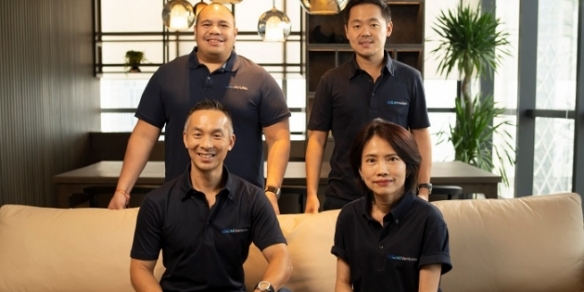Open standards, co-creation to drive networks: Juniper chief: Page 2 of 2
By A. Asohan January 27, 2015
 The following is a Q&A between DNA and Rahim:
The following is a Q&A between DNA and Rahim:
DNA: The SDN concept introduces a new control layer that sits between the traditional hardware and software layers of the network. It allows for the easier configuration, control, and administration of networks, reducing costs while increasing speed and flexibility of deployment.
While the industry has been touting its benefits, observers have noted on more than one occasion that one challenge is the need for standards. What is Juniper doing with regard to this?
Rahim: Because Juniper is a ‘challenger’ in the networking industry – we’ve always been a challenger, when we started this company, we were a challenger – one of our most important tenets has been the openness of the interfaces we choose for our products.
The appropriate strategy for an incumbent is to keep the interfaces closed, so as to keep out the challengers. To the challenger, open interfaces are your best friend because they level the playing field.
So we’ve never lost sight of how important it is for us to maintain the openness of all the interfaces we choose in our solutions, wherever possible. Even if there is a need to develop a new interface, it’s very important to take those interfaces to standards-based bodies.
Today, again, because of the separation of the different networking elements under the SDN and NFV paradigms, the openness of the interfaces between these elements become crucial, and why many of solutions resonate so much with our customers.
This includes things like using standards-based interfaces between the controller and our networking element – so today, for example, our network controller, the Contrail product, and all our networking elements are on the standards-based Border Gateway Protocol (BGP) that provides that connection.
[Last December, the company introduced the OCX1100, a networking switch that combined Open Compute Project (OCP) hardware design with its carrier-class network operating system, Junos OS.
The new switch, which will be available in the first quarter of 2015, provides customers which build large and massive scale data centres with an open, cost-effective, disaggregated switching platform, Juniper said.
Combining Junos OS with OCP submitted hardware delivers a unique solution that removes the burden of support, installation and maintenance from cloud providers while delivering on the promise of an open source hardware design, it claimed.
The OCX1100 will provide large cloud providers with proven software and open source network hardware that is much easier to deploy, integrate and support, it added]
DNA: Towards the end of last year, as with many vendors, Juniper released its technology predictions for 2015. One trend it believes that will take off this year is the idea of co-creation. The networking industry, ironically, has always been a one-way street: Vendors develop products such as routers and switches, and sell them to enterprises and service providers. Enterprises and service providers buy them.
In 2015, Juniper said this will change. More large companies and service providers will become more vocal about the features and prices of the products they buy for their networks, and you expect to see more products in 2015 co-created between partners, customers and network equipment makers, as customers wield more influence in the development of the modern network.
With no clear separation between vendor and customer, does Juniper’s open standards approach and open interface tenets give it a competitive edge in the co-creation space?
Rahim: Absolutely. SDN and NFV provide for the ability for more granular innovation in different areas.
What I mean by that is that if you have developed an end-to-end solution to provide virtualised networked services to an end-user, that solution consists of connectivity from the end-user to the services; it consists of the hardware infrastructure that can provide the performance and scalability that’s necessary; and it also consists of the virtualised network functions.
It is not necessary that Juniper provide all the virtualised network functions. They are separate modules, they reside in virtual machines sitting inside of a data centre – and they can be developed by us, they can be developed by our customers, they can be developed by our partners.
The most important thing that our customers look for is the ability to stitch these services together, in an open and seamless manner so that the end-user has no notion of the complexity behind the scenes as to how those services are being delivered.
We want to empower our customers to do just that. We empower them by providing them with an open platform and open interfaces that allow them to develop these services.
We also empower them in many cases by working directly with them, as one team. This is what I think of as co-creation: It’s Juniper engineers and our customers’ engineers, working together as one team, sleeves rolled up, with an innovation agenda in mind of developing these applications.
This is to me, a paradigm shift in how we will engage with our customers today, and in the future … and a very exciting shift for the industry because I think it promises to accelerate the pace of innovation altogether.

DNA: Do you see many customers in this part of the world pushing your envelope in this way?
Rahim: I believe so. In fact, I just had a meeting with one of our large customers today, who was very supportive of engaging with this approach.
This is not unique to this region, you really see it all over the world, but there are very some very progressive, forward-thinking customers in this country [Malaysia] that are leaders worldwide, I would say, in adopting this approach for co-innovation.
When things are changing this rapidly in this industry, or any industry, it’s impossible to come out with a grand plan that one executes on flawlessly. The only thing that’s possible really, is that you can do some level of planning, but beyond that you’ve got to roll up your sleeves, attack the problem, learn along the way, adapt along the way, and solve the problem as one team.
And when I say ‘one team,’ what I mean is engineers working together, product managers working together – and they know each other on a first-name basis, they have each other’s numbers on speed dial, they spend a lot of quality face-time together, so much so that the line between the two companies becomes blurry at best.
DNA: So does that mean you’re going to need more human resources on the ground in this country?
Rahim: I think it means that there is an element of human resources that is required, but that is not just in this country because I am talking about the developers of the products themselves.
So that might mean more teleconferencing, more travel time, more of a balanced skills set for our developers where they’re not only writing code and building hardware and developing software, but interfacing – transmitting and receiving information, and building that into plans and so forth.
It’s a bit of a skills-set shift in that it’s something that we’re working on, and we do that with a focused group of customers that we’re fully engaged with.
DNA: How many customers in Malaysia are you doing that with?
Rahim: Only a few to begin with – a couple which are interested in engaging in this way, several in the region, and a few handfuls worldwide.
Different customers are going to be more comfortable doing this at different times, and certainly I think the larger ones have more of an internal development capacity to do this, so it’s going to be the larger ones initially.
DNA: In the Asia Pacific region, which vertical industries are interested in engaging with you and pushing the envelope this way?
Rahim: The verticals that Juniper is focused on worldwide telcos, cable operators, government, financial services, web services providers and other strategic verticals where you have large enterprises which typically view their networks as so mission-critical for them that they almost behave like service providers and they value the same capabilities.
Worldwide, examples of companies that behave this way would be a UBS or a Nike. These are large global enterprises where their IT organisations act like service providers for the rest of their internal constituents.
In Malaysia and the region, telcos, cloud providers in particular, and financial services organisations are verticals that have particularly pushed to engage with us this way.
In fact, the other dimension of this need for open interfaces, next to partnerships with customers, is that Juniper is at a size where we’re clearly not a startup, we’re a large global organisation – but we’re not like many of our peers, which are about 10 times larger.
To us, this means that we have the relevance we need, to be sitting at the table with the largest telcos and cloud providers and large enterprises around the world, but we’re not so large that we can’t move fast enough to adapt to some of these transformations in the industry.
It also means that we have to be better than everybody else in partnerships. We’re going to need to make it very easy for our partners to work with us.
Take for example our partnership with (cloud and virtualisation company) VMware, where we’re now co-developing solutions that use VMware automation inside of the data centre, along with our infrastructure.
Another example would be our partnership with Aruba, where customers can tap into best-of-breed products in the domain of wireless LAN (local area network) and wired infrastructure and security, but don’t have to worry about whether those technologies are going to work together seamlessly – they want to make sure they work together out-of-the-box.
This is why we’re developing solutions that are pretested with Aruba.
A big part of our strategy for growth in this region would be the partnerships that we have, and we recently announced a very broad partnership with VMware in this region which has got quite a bit of attention.
DNA: What do customers ask you about when it comes to security, and big data and the strain on the network it is causing?
Rahim: As the industry moves towards cloud-based delivery models, the need for security becomes a lot more. There is a need for large, tall firewalls at the perimeter of the cloud to protect traffic going in and out.
Today, it’s not a question of whether a private or public cloud will get attacked, it is a question of when; it’s not even a question of whether the attackers will succeed – they will succeed at some point or the other – so the question is how do you prevent an attack from spreading inside of the cloud, inside of the large campus environment when it happens.
And so the architectures that we’re discussing with our customers revolve around a virtualised security offering that enables us to protect data that is going east-west, between different departments of a data centre, between tenants.
A big part of our focused investment into security is around the performance that is necessary to keep attackers out, as well as the virtualised security offerings that can prevent attacks from spreading once they’ve inevitably penetrated.
For that reason, when we think about our cloud-based offering, security is truly an inextricable part of the end-to-end solution. And our customers recognise this.
DNA: You’re here in Malaysia for one day, and then leaving for China, followed by Japan. So what are you going to do in one day? Next to meeting DNA, that is ….
Rahim (chuckles): I had the opportunity to meet some of our customers here, and it’s always good to meet with customers to make sure you’re aligned strategically, and to understand the special needs of that particular customer, as well as the region.
While I am here, I will be talking about what the particular solutions are that can help solve the problems that need to be solved.
There are big transformations that are happening in the industry today, so I need to understand where customers are on this journey to take advantage of some of these new approaches to service delivery on the network, and to make sure that we’re capturing all of this in our company as part of our strategy.
DNA: What are Malaysian companies telling you? What are their concerns right now?
Rahim: Well, in some sense, there are common themes throughout the world today. The massive transformations happening in the industry today, I view as a huge opportunity.
There is a movement towards a cloud-based service delivery model, with the promise of far greater agility to deliver services to end-users. The ability to adapt to new services, the ability to roll out new services with much more automation, is the goal everyone’s aiming for.
Now, when people think about the cloud, and the infrastructure that is required to enable it, it’s about providing the secure networking infrastructure that’s inside the data centre; it’s about providing the infrastructure to connect data centres together; it’s also very much about providing the connectivity between the data centres and the consumers of those cloud-based services.
Malaysia has some incredible initiatives right now, around Digital Malaysia for example, where moving towards much more advanced high-performance, highly scalable infrastructure that can connect cloud-based services to the end-users is there.
It’s an ambitious programme, and it’s something that puts the goals of this country very much aligned with the goals, the strategy, the capabilities, and the DNA of Juniper.
We started this company with tremendous amount of capability for pushing the envelope on scale and performance, and that helps in cloud-based service delivery models.
What we’re doing now at Juniper, and part of my innovation agenda for the company, is to invest heavily in automation and software-driven innovation to provide the tools to simplify network operations and to provide that agility there that everybody’s looking for.
Previous Instalment: The 3 biggest networking shifts, from the new Juniper CEO
Related Stories:
Aruba and Juniper to connect on converged high-IQ enterprise networks
Top 10 reasons to use open source software-defined networking
Software-defined push: Juniper expands APAC pact with VMware
Networking needs a new paradigm in SDN: Gartner
For more technology news and the latest updates, follow us on Twitter, LinkedIn or Like us on Facebook.


